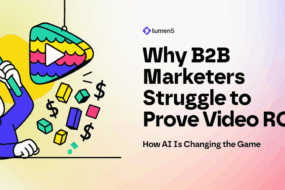
Are you considering including video marketing in your content strategy? This is a great idea if you want to take your strategy to a new level. According to the Content Marketing Institute, marketers spend up to 40% of their budgets developing content.
The question is, how to use your budget wisely when it comes to developing a solid content strategy? the answer lies in video marketing.
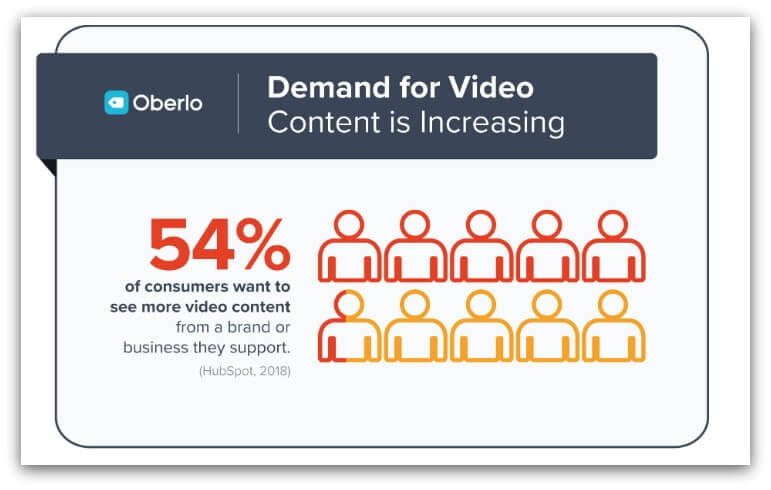
According to Oberlo, 54% of users want to see more video content of a business or brand they support.
Now, you and I know that video and marketing go together in 2019. So, you want to take a look at this guide on how to get started with video marketing.
If you find yourself trying to convince internal stakeholders in your company to invest in video marketing, or if you are a solo entrepreneur, this article is for you.
Video Marketing in Your Content Strategy
When you study the effectiveness of video and the market’s demand for visual content, it is clear that video is the future.
Take a look at the following image HubSpot published this year
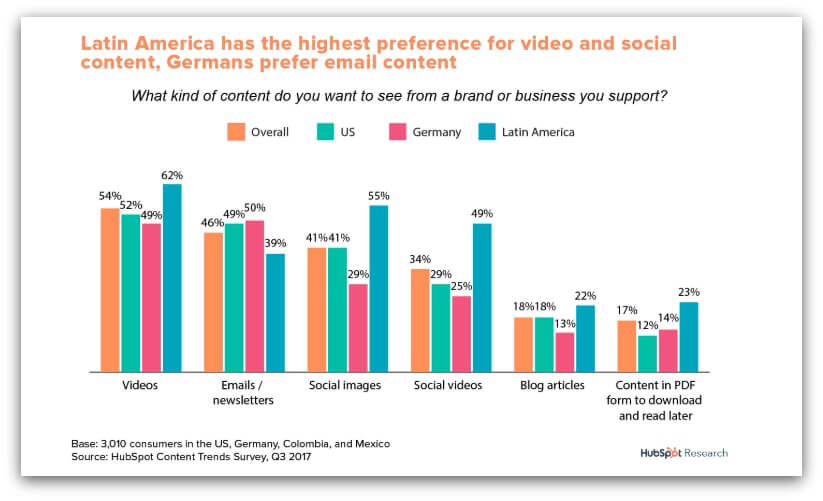
It is already a staple of our everyday lives — it’s everywhere: YouTube, Vimeo, Snapchat, Instagram Live, Facebook Live, and the list goes on.
Over the past few years, marketers have become so focused on the need to blog that they’ve ignored a far more powerful medium: video.
Writing blog posts, templates, books and other marketing content requires a certain skill set but it’s pretty straightforward for anyone who is a good communicator.
To them, the process of planning and producing a video may seem too challenging.
Here is where we can rely on video marketing statistics to take that first step and make our content strategy as solid as it can be.
Content Strategy Statistics
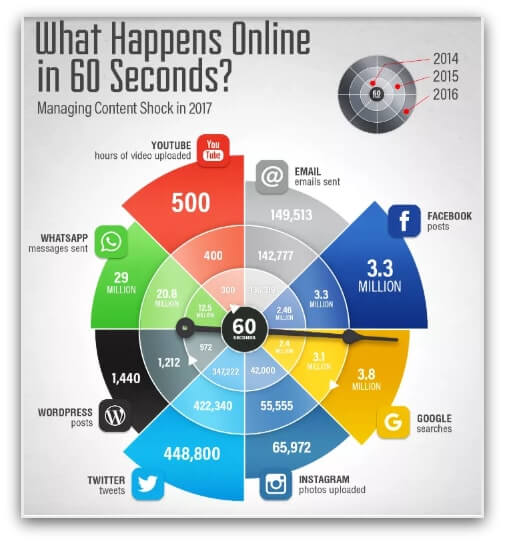
Here is a graphic by getgist, where you can see where on the internet people consume content.
As you can see, people spend a great deal of time on YouTube, Facebook, Instagram, and Twitter. It is here where people watch thousands of hour of videos every day.
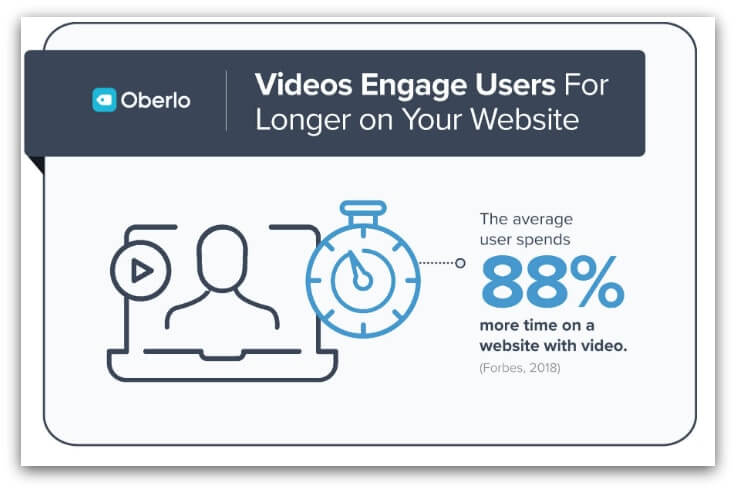
Also, according to Oberlo, the average user spends 88% more time on your website if it includes video content.
The time has come for us to adapt and face the reality that video is king and it should be part of our content strategy. If you haven’t adopted video fully in 2019, you are not just falling behind; you are behind.
Why Include Videos in My Content Strategy?
There are countless reasons why you should include video marketing as part of your content strategy whether your an author promoting a book, marketing real estate, or a social media manager.
- Video Is good for SEO
- Higher engagement and conversion rates
- Video Means Mobile-First
- It has an impact on your social channels
Video Is Good for SEO
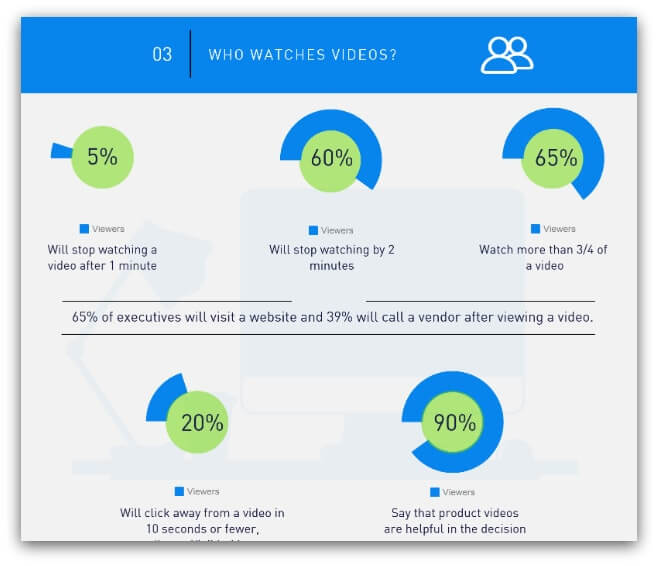
The more video content you produce, the more likely you will appear in top search results.
Adding a video to your post can increase your reach and visibility dramatically: in fact, it can increase your chances of making it to the top of Google search results, according to HubSpot. Video content opens up an entirely new audience that can find you, and then buy your products and services.
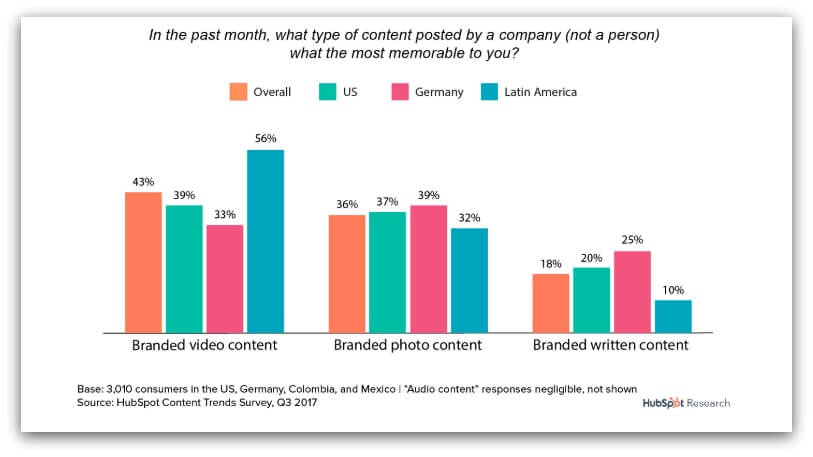
Also consider that YouTube is the second largest search engine, second to Google. If you’re regularly creating YouTube videos on topics that people care about, then you will likely end up at the top of YouTube search results.
For example, if you’re a fashion brand, simply creating a “how to” styling video can be the key to getting tens of thousands of views.
Video Has Higher Engagement and Conversion Rates
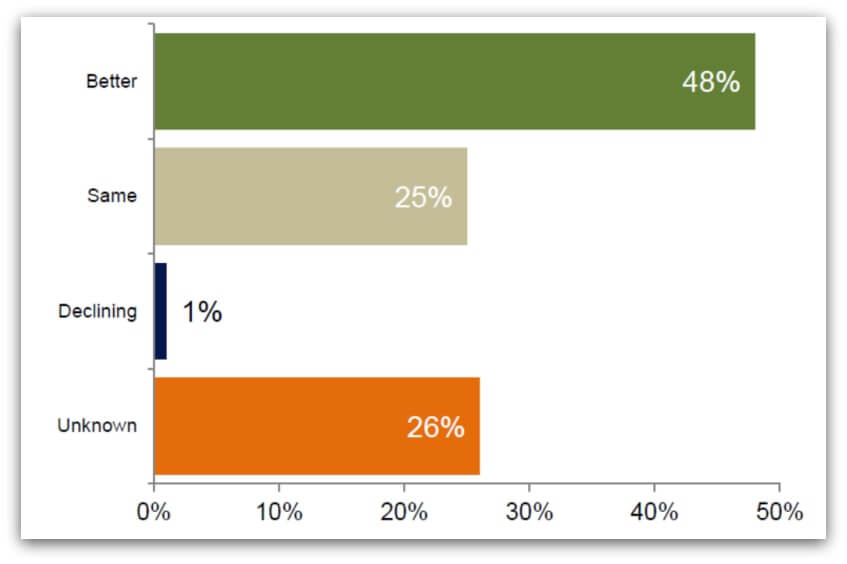
Video not only increases visibility, but it also increases engagement. People are more likely to share and repost video content than any other type of content by a country mile.
71 percent of marketers say that videos have converted better than all other types of content. They also find it easier to measure all the metrics that matter with video: click-through rates, total views, partial views, drop-off points, and conversion rates.
Simply put, people are more likely to purchase your products if they watch a video about your products. That may be promoting books to read like what these BookTube channels do or swag like YesTheory‘s ecommerce line, SeekDiscomfort.
Video Means Mobile-First
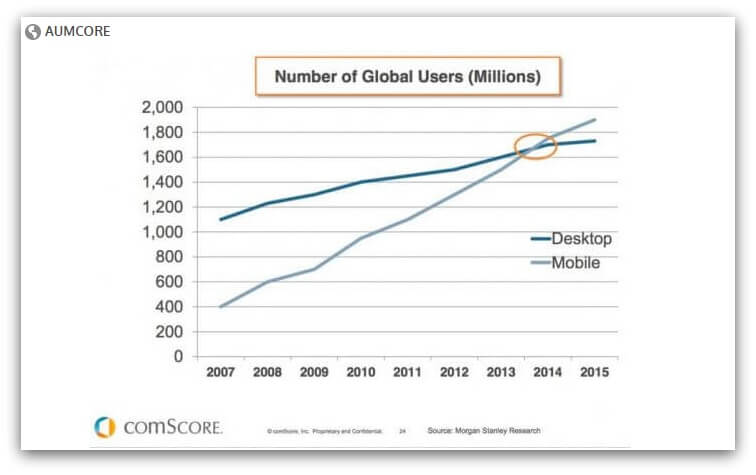
People are consuming more and more content on their phones and a large percentage of that content is video, according to a study conducted by ZeenithMedia. If you want people to see your content, it has to be the type of content that is going to show up on their phones, i.e., video.
The video consumption trend has accelerated thanks to Facebook, which arguably embraces video more than any other social network. Their algorithm favors video: video content is more likely to show up on peoples’ news feeds than any other type of content.
Moreover, if someone is casually scrolling through their Facebook updates, the movement of video is more likely to capture their attention and get them to stop scrolling. That is true for other feed-based platforms like LinkedIn and Twitter.
Measure the Impact of Video on Your Social Channels
Here is a simple exercise you can carry out to measure the impact of video on your social media channels.
- Pick your most heavily used social channel that has both video and image/non-video posts.
- Go through every post within the last 3 months and track the number of likes, comments, shares, and any sort of engagement, in a spreadsheet. (Be sure to mark which post is a video and which is a non-video post.)
- Sum up the likes, comments, shares, and other engagement metrics of the video posts and the non-video posts separately.
- Calculate the average engagement on video posts and non-video posts.
- Calculate the percentage increase (take the average likes for video posts and minus the average likes of non-video posts. Divide that number by the average likes of non-video posts.).
- Do that calculation for each type of engagement you tracked.
- Use those numbers to sell the importance of video.
This exercise is effective as it not only gives you an accurate idea of how well your video posts fare in contrast to your non-video posts; but it also allows you to more accurately predict actual increases in overall user engagement if more video is added to the mix.
Drop Some Stats
Video marketing is not only convenient and efficient for consumers, it provides marketers with a versatile and highly shareable medium to reach their audiences. Diode Digital conducted a study and found that online video is 600 percent more effective than print and direct mail combined.
Perhaps because video traffic accounts for 75 percent of all consumer traffic (and that percentage will increase to 82 percent by 2022).
The importance of video marketing is already pretty clear but let’s take a look at how instrumental it has been to the success of brands like Dropbox.
Successful Content Strategies That Included Video Marketing
Dropbox Content Strategy
When Dropbox first launched, just like PB&J, the concept was fairly uncommon. So they decided to drop a video on their landing page to explain what their service is and how it works.
After adding that video to their landing page, Dropbox immediately experienced a 10 percent increase in conversions. That percentage increase could’ve been even higher as adding a video to a landing page can boost conversions by 80 percent. Yes, videos can make you some serious money.
Let’s analyze Dropbox’s case a bit more.
Their video was successful because it helped users understand their product and how to use it. They didn’t rely on heavy text — in fact, the video stood alone on the landing page with minimal distraction.
Think about it from Dropbox’s perspective: If someone can’t connect with your product or brand, why would they stick around to learn more? The problem your product addresses, and its solution, needs to be clear and concise.
So, do away with landing pages with crowded text (that will go unread) and insert a video instead.
The Local Search Association (LSA) surveyed 2,000 consumers and found that 44 percent of consumers viewed online video while searching for products and services. Their research also found that 53 percent of viewers contacted a business after watching a video and 51 percent visited the company’s website.
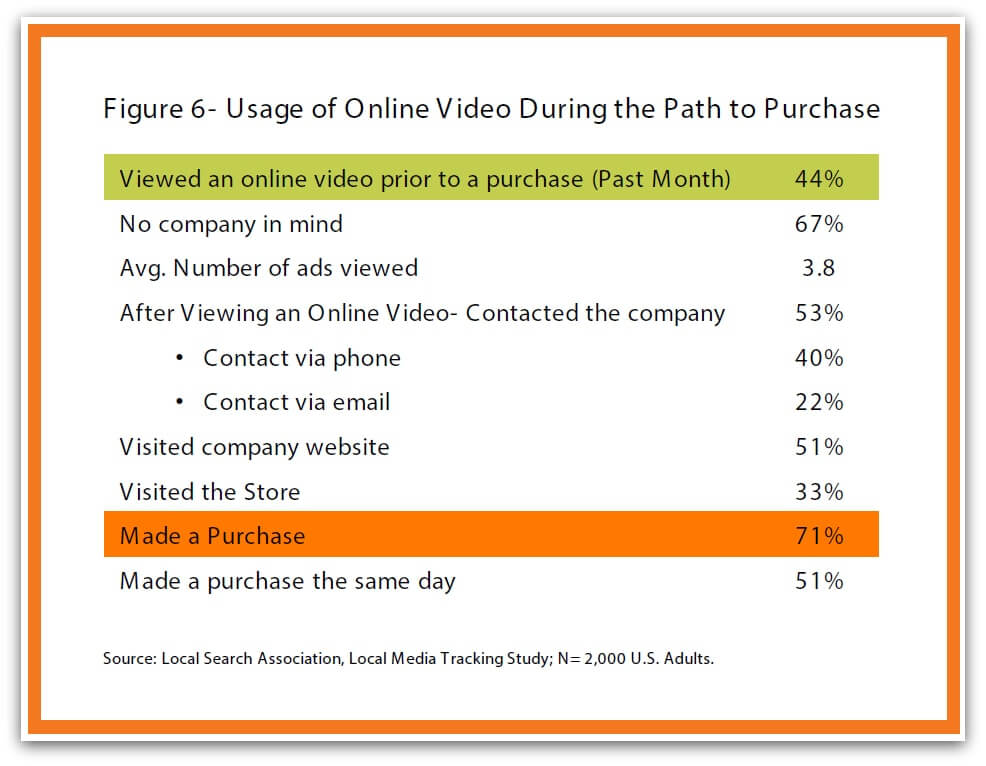
Credit: Search Engine Land
Viewers are also 85 percent more likely to purchase a product after watching a product video and they spend 100 percent more time on pages with videos.
Those are some pretty convincing stats.
Let’s look at another example of a brand that used video marketing to blow up — in a good way.
Dollar Shave Club’s Content Strategy
Have you heard of the Dollar Shave Club? Any North-American male between the ages of 17 and 30 would say, “yeah!” A lot of women know about it too.
Dollar Shave Club (DSC) is a classic example of a startup that blew up because of a viral video (below). A video that now defines their brand and still drives them sales.
DSC identified a concept that resonates with their audience and delivered it with a voice and personality (punchlines and gags) that draws their audience in, forming a one-on-one connection with them. They basically nailed this video.
It racked up 5 million views within the first 90 days and now has close to 26M views. It is a video users will remember (and even keep going back to) for a while.
In fact, 80 percent of users can recall a video ad they viewed in the past 30 days. A study by Unruly found that enjoyment of video ads increase purchase intent by 97 percent and brand association by 139 percent.
Dollar Shave Club’s viral video took them from a startup to a multi-million dollar company almost instantaneously. That’s a pretty convincing reason why you should capitalize on consumer behavior with video.
As consumers find the information they need through video, let them discover your brand with an entertaining and informative video.
Content Strategy Template
When designing a solid content strategy, it is important that you have a clear picture of what you want to achieve.
If you really want to rank any content and generate traffic, you have to understand how search engines really work today.
In the past, just writing a bunch of weywords that sometimes didn’t even make sense was enough to rank your site on the first page on Google.
Unfurtunatley, or fortunately, thigs have changed. Now, search engine are geting better at recognizing intent over keywords. So a term like “where can I have a coffee” might work better than “cafés in my city”
This means you can use topic clusters instead of keywords to build your site’s architecture. If you want to understand this concept better, take a look at the following video published by HubSpot
So, if you want to follow a simple template to create a solid content strategy, just focus on the following
| Plan | Course of Action |
|---|---|
| 1. Define a clear goal | It is important to write down your ultimate goal. What do you want to achieve? |
| 2. Find your target audience | Find a group of people with a need in common. Decide if you can provide them with what they want and conduct research on their preferences at the moment. |
| 3. Think of the type of content you want to create | Following the previous step, think of the content that would be best for your TA. The most popular option here is always video marketing. |
| 4. Select the right creation tool | There are many creation tools out there. One of the most popular is Lumen5 to create short and professional videos |
| 5. Choose the right publishing tool | Find one tool that helps you publish your content on different platforms. This will make it easier to keep control of your posts. |
| 6. Find the ideal posting frequency | You want to keep posting interesing content with a frequency people enjoy. You don't want to annoy the with too much content. |
A Solid Content Strategy
“Go where your customers are”
One of the more common sayings among marketers. Right now, customers are on mobile and they are consuming video content at an exciting rate. If you want to be relevant, you have to make video a part of your marketing strategy.
Google is also putting more emphasis on videos so we consume more and more videos, daily. If you don’t have a strong video strategy, you’ll be missing out.
But we get it, it’s not entirely up to you. It is; however, up to you to explain the importance of video, and what it can achieve regarding business growth to internal stakeholders. Also, Refer to this article anytime you need to convince anyone that video is the best marketing tactic for today and tomorrow.




